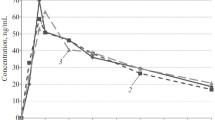Summary
In a group of patients studied for 12 months after myocardial infarction plasma levels of phenytoin were measured whilst the patients received phenytoin 300–400 mg per day or placebo therapy. Two sub-groups of patients treated with phenytoin were identified, based on the steady state level of plasma phentyoin concentration. Patients who had achieved phenytoin plasma concentrations of 10 µg/ml or above, had a significantly lower mortality than patients who had plasma concentration below this level or than patients treated with placebo. Ventricular premature beats occurred significantly less often in the phenytoin treated group than among the comparative group of patients. The significance of these findings is discussed.
Similar content being viewed by others
References
Bigger, T.J., Schmidt, D.H., Kutt, H.: Relationship between the plasma level of diphenylhydantoin and its cardiac antiarrhythmic effects. Circulation38, 363–374 (1968).
Buchthal, F., Svensmark, O.: Aspects of the pharmacology of phenytoin (Dilantin) relevant to their dosage in the treatment of epilepsy. Epilepsia (Amster.)1, 374–384 (1960).
Burns, J.J.: Species differences and individual variations in drug metabolism. Metabolic factors controlling duration of drug action. Brodie, B.B. and Erdos, E. (Eds.). Oxford: Pergamon Press 1962.
Butler, T.C.: The metabolic conversion of 5-5-diphenylhydantoin to 5-(p-hydroxyphenyl)-5-phenalhydantoin. J. Pharmacol. exp. Ther.119, 1–11 (1957).
Collaborative group. Phenytoin after recovery from myocardial infarction. Lancet1971 II, 1055–1057.
Cutler, S.J., Ederer, F.: Maximum utilization of the life table method in analysing survival. J. chron. dis.8, 699–712 (1958).
Davies, D.S.: Cytochrome P 450 and drug oxidation. Biochem. J.115, 23P–24P (1969).
Hammer, W., Idestrom, C.M., Sjoqvist, F.: Proc. 1st Int. Symposium on Antidepressant Drugs. Excerpta Medica. Int. Congress Series (1966).
Kutt, H., Winters, W., Kokenge, R., McDowell, F.: Diphenylhydantoin metabolism, blood levels and toxicity. Arch. Neurol. (Chic.)11, 642–648 (1964).
Kutt, H., Haynes, J., McDowell, F.: Studies of diphenylhytantoin metabolism. Trans. Amer. neurol. Ass.90, 265–266 (1965).
Loeser, E.W., jr.: Studies on the metabolism of diphenylhydantoin (Dilantin). Neurology (Minneap.)11, 424–429 (1961).
Lown, B., Kosowsky, B.D., Klein, M.D.: Pathogenesis prevention and treatment of arrhythmias in myocardial infarction. Circulation Suppl.4, 39/40, 261–267 (1969).
Mixter, C.G., Moran, J.M., Austen, W.G.: Cardiac and peripheral vascular effects of diphenylhydantoin sodium. Amer. J. Cardiol.17, 332–338 (1966).
Rawlins, M.D., Smith, S.E.: Medical progress: Clinical Pharmacology. British Encyclopaedia of Medical Practice, 70–94. London: Butterworths 1971–1972.
Stensrud, P.A., Palmer, H.: Serum phenytoin determinations in epileptics. Epilepsia5, 364–370 (1964).
Vajda, F.J.E.: The value of phenytoin plasma levels in the treatment of epilepsy. Med. J. Aust.2, 1074–1076 (1970).
Vajda, F.J.E., Prineas, R.J., Lovell, R.R.H.: Interaction between phenytoin and the benzodiazepines. Brit. med. J.1, 346 (1971).
Vajda, F.J.E., Fennessy, M.R., Prineas, R.J., Abernethy, M. H.: Interaction between the benzodiazepines and phenytoin in animals. Submitted for publication.
Wallace, J.E.: Microdetermination of diphenylhydantoin in biological specimens by ultraviolet spectrophotometry. Anal. Chem.40, 978–980 (1968).
Zeft, H.J., Whalen, R.E., Ratliff, N.B., Davenport, R.D., McIntosh, M.D.: Diphenylhydantoin therapy in experimental myocardial infaraction. J. Pharmacol. exp. Ther.162, 80–84 (1968).
Author information
Authors and Affiliations
Rights and permissions
About this article
Cite this article
Vajda, F.J.E., Prineas, R.J., Lovell, R.R.H. et al. The possible effect of long-term high plasma levels of phenytoin on mortality after acute myocardial infarction. Eur J Clin Pharmacol 5, 138–144 (1973). https://doi.org/10.1007/BF00564893
Received:
Issue Date:
DOI: https://doi.org/10.1007/BF00564893




